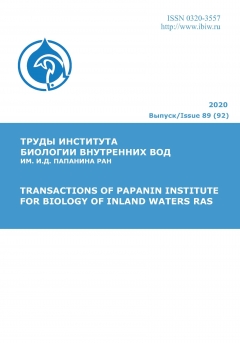UDC 591.392
The genome size of the bream Abramis brama (L., 1758) is 1.3 times larger than that of the roach Rutilus rutilus (L., 1758), indicating a larger volume and diversity of noncoding DNA available for selection, which may be a source of latent genetic variability facilitating better co-adaptation of heterogeneous genomes during distant hybridization between these species. The evolutionary significance of genome size remains unclear. Analysis of random multilocus polymorphism (RAPD) markers and non-specific esterases was performed in A. brama and R. rutilus to identify the relationship with genome size. These markers cover both coding and non-coding regions of DNA, allowing analysis of the genome as a whole. The total number of loci identified for two RAPD primers in individual spectra of roach and bream was 89, of which 10 were common, and 18 (in roach) and 33 (in bream) were species-specific monomorphic. Both samples were highly polymorphic and differed significantly; the bream sample was more homogeneous. The spectra of non-specific esterases of the liver and skeletal/cardiac muscles of roach and bream were heterogeneous with coinciding electrophoretic mobility of the zones. The main Est-2 zone with the absence of tissue specificity in both species is a product of an independent locus and is represented by three allelic variants in roach (six genotypes were identified) and one component with high activity in bream. Polymorphism of this zone in bream is manifested by its division into two components with a low frequency of genotype occurrence (0.06), which may be a consequence of a mutation that has no adaptive value. The Est-1 zone of bream is tissue-specific, in the liver there is one component with high activity, in the heart - three with a predominance of homozygotes, in the serum - two fragments with weak activity and not in all individuals. In roach, the Est-1 zone of the liver is represented by two fractions with high activity, three components were identified in the heart, and the Est-3 zone has four allelic variants (nine genotypes). Thus, with an increase in the genome size of bream compared to roach, a decrease in the allelic diversity of esterase loci and a greater similarity of individuals to each other is shown, which may indicate a low variability of the structural genes encoding this protein, and a difference in the regulatory systems of the parental genomes.
Cyprinidae, roach, bream, non-specific esterases, RAPD, polymorphism, genome size
1. Altuhov Yu.P. Geneticheskie processy v populyaciyah. M.: Akademkniga, 2003. 431 s.
2. Alferova N.M., Nefedov G.N. Elektroforeticheskoe issledovanie myshechnyh esteraz nekotoryh vidov ryb Vostochnoy Atlantiki // Biohimicheskaya genetika ryb: sb. tez. dokl. 1-go Vses. Soveschaniya. 1973. S. 195–200.
3. Andreeva A.A. Strukturno-funkcional'naya organizaciya belkov krovi i nekotoryh vnekletochnyh zhidkostey ryb. Dis. … dok. biol. nauk. Borok, 2008. 271 s.
4. Berdnikov V.A. Evolyuciya i progress. Novosibirsk: Nauka, 1991. 192 s.
5. Ginatulin A.A. Struktura, organizaciya i evolyuciya genoma pozvonochnyh. M.: Nauka, 1984. 293 c.
6. Zhivotovskiy L.A. Populyacionnaya biometriya. M.: Nauka, 1991. 268 s.
7. Kartavcev Yu.F. Molekulyarnaya evolyuciya i populyacionnaya genetika. Vladivostok: Izd-vo Dal'nevost. un-ta. 2005. 304 s.
8. Kirpichnikov V.S. Genetika i selekciya ryb. L.: Nauka, 1987. S. 233–236.
9. Korochkin L.N., Serov O.L., Pudovkin A.I. i dr. Genetika izofermentov. M.: Nauka, 1977. 275 s.
10. Korochkin L.N. Nekotorye molekulyarnye aspekty regulyacii ekspressii genov u ryb i drugih eukariot // Biologicheskie osnovy rybovodstva: problemy genetiki i selekcii. L.: Nauka, 1983. S. 34–51.
11. Kuz'min E.V. Izozimnye spektry esteraz syvorotki krovi lescha (Abramis brama L.) reki Volgi // Voprosy ihtiologii. 1984. T. 24. Vyp. 3. S. 508–511.
12. Kryzhanovskiy S.G. Ekologo-morfologicheskie zakonomernosti razvitiya karpovyh, v'yunovyh i somovyh ryb (Cyprinidei i Siluruidei) // Trudy instituta morfologii zhivotnyh. 1949. Vyp. 1. 362 s.
13. Lapushkina E.E. Ekologo-geneticheskiy analiz rannego razvitiya otdalennyh gibridov F1 lescha (Abramis brama L.), plotvy (Rutilus rutilus L.) i sinca (Abramis ballerus L.). Dis. … kand. biol. nauk. Borok: IBVV RAN, 2002. 144 s.
14. Leypol'dt M., Shmidtke I. Ekspressiya genov u filogeneticheski poliploidnyh organizmov // Evolyuciya genoma. M.: Mir, 1986. S. 217–232.
15. Ludannyy R.I. Geneticheskaya identifikaciya i differenciaciya predstaviteley semeystva Karpovyh (Cyprinidae). Dis. … kand. biol. nauk. M.: In-t. biol. gena RAN, 2008. 140 s.
16. Mustafin R.N., Husnutdinova E.K. Nekodiruyuschie chasti genoma kak osnova epigeneticheskoy nasledstvennosti // Vavilovskiy zhurnal genetiki i selekcii. 2017. T. 21. № 6. S. 742–749. DOI:https://doi.org/10.18699/VJ17.30-o.
17. Patrushev L.I., Minkevich I.G. Problema razmera genomov eukariot // Uspehi biologicheskoy himii. 2007, T. 47. S. 293–370.
18. Rayder K., Teylor K. Izofermenty. M.: Mir, 1983. 103 s.
19. Rudakova A.S., Rudakov S.V., Davydova N.V. i dr. Izofermentnyy analiz esteraz v zrelyh semenah geksaploidnoy myagkoy pshenicy (Triticum aestivum L.) // Sel'skohozyaystvennaya biologiya. 2016. T. 51. № 3. S. 327–334. DOI:https://doi.org/10.15389/agrobiology.2016.3.327rus.
20. Serov O.L. Genetika izofermentov zhivotnyh i cheloveka // Genetika izofermentov. M.: Nauka, 1977. S. 80–149.
21. Slyn'ko Yu.V. Polimorfizm myshechnyh izofermentov karpovyh ryb SSSR. I. Laktatdegidrogenaza // Informacionnyy byulleten' “Biologiya vnutrennih vod”. S.-Pb.: Nauka, 1991. № 90. S. 75–84.
22. Slyn'ko Yu.V. Polimorfizm myshechnyh izofermentov karpovyh ryb. III. Malik–enzim // Informacionnyy byulleten' “Biologiya vnutrennih vod”. S.-Pb.: Nauka, 1992. № 95. S. 64–72.
23. Stolbunova V.V., Hlystov D.N. Nespecificheskie esterazy organov i tkaney plotvy Rybinskogo vodohranilischa // Ekologicheskie problemy basseynov krupnyh rek-3: sb. tez. dokl. mezhdunarodnoy i molodezhnoy konferencii. Tol'yatti, 2003. S. 275.
24. Stolbunova V.V. Mezhgenomnyy konflikt pri otdalennoy gibridizacii plotvy (Rutilus rutilus L.) i lescha (Abramis brama L.) // Uspehi sovrem. biologii. 2017. T. 137. № 4. S. 361–372. DOI:https://doi.org/10.7868/S0042132417040044.
25. Stolbunova V.V., Koduhova Yu.V. Nasledovanie ITS1 rDNK u reciproknyh gibridov plotvy Rutilus rutilus (L.) i lescha Abramis brama (L.) v rannem ontogeneze // Uspehi sovrem. biologii. 2021. T. 141. № 1. S. 66–77. DOI:https://doi.org/10.31857/S0042132421010233.
26. Tammert M.F. Geneticheskaya harakteristika lescha (Abramis brama L.) v nekotoryh tochkah areala // Vid i ego produktivnost' v areale. Vil'nyus-Palanga. 1980. S. 57–58.
27. Hlystov D.N. Nespecificheskie esterazy lescha Verhney Volgi // Ekologicheskie problemy basseynov krupnyh rek-2. Tol'yatti. 1998. S. 265–266.
28. Hrisanfova G.G., Ludannyy R.I., Slyn'ko Yu.V. i dr. RAPD fingerprint lescha (Abramis brama), plotvy (Rutilus rutilus) i gibridov pervogo pokoleniya lesch × plotva i plotva × lesch // Genetika. 2004. T. 40, № 10. S. 1432–1436.
29. Flavell R.B. Sequence amplification, deletion and rearrangement: major sources of variation during species divergence // Genome Evolution. L.: Academic Press, 1982. P. 301–324.
30. Gangloff S., Zou H., Rothstein R. Gene conversion plays the major role in controlling the stability of large tandem repeats in yeast // EMBO J. 1996. Vol. 15. P. 1715–1725.
31. Koehn R.K., Eanes W.F. Subunit size and genetic variation of enzymes in natural populations of Drosophila // Theor. Pop. Biol. 1977. Vol. 11. P. 330–341. DOI:https://doi.org/10.1016/0040-5809(77)90016-8.
32. Koonin E.V., Wolf Y.I. Evolutionary Systems Biology: Links Between Gene Evolution and Function // Curr. Opin. Biotechnol. 2006. Vol. 17. P. 481–487. DOI:https://doi.org/10.1016/j.copbio.2006.08.003.
33. Lane N., Martin W. The energetics of genome complexity // Nature. 2010. Vol. 467. P. 929–934. DOI:https://doi.org/10.1038/nature09486.
34. Lane N. Mitonuclear match: optimizing fitness and fertility over generations drives ageing within generations // Bioessays. 2011. Vol. 33. P. 860–869. DOI:https://doi.org/10.1002/bies.201100051.
35. Nei M. Molecular evolutionary genetics. N.Y.: Columbia Univ. Press, 1987. 512 p.
36. Nyman O.L. Species specific protein in freshwater fishes and their suitability for a “Protein taxonomy” // Hereditas. 1965. Vol. 53. R. 117–126.
37. Pankova V.V., Pudovkin A.I., Manchenko G.P. Allozymic variation determined by alternatively spliced exon of the GPI gene in Polydora brevipalpa (Polychaeta: Spionidae) // GFI Bull. 2004. Vol. 37. P. 30.
38. Pierron D., Wildman D.E., Hüttemann M. et al. Cytochrome c oxidase: Evolution of control via nuclear subunit addition // Biochim Biophys Acta. 2012. Vol. 1817. № 4. R. 590–597. DOI:https://doi.org/10.1016/j.bbabio.2011.07.007.
39. Pierce B.A., Mitton J.B. The relationship between genome size and genetic variation // Am. Nat. 1980. Vol. 116. P. 850–861.
40. Prokopowich C.D., Gregory T.R., Crease T.J. The correlation between rDNA copy number and genome size in eukaryotes // Genome. 2003. Vol. 46. P. 48–50.
41. Shaklee J.B., Allendorf F., Morisot D.C., Whitt G.S. Genetic nomenclature for protein-coding loci in fish: proposed guideline // Trans. Am. Fish. Soc. 1989. Vol. 118. P. 218–227.
42. Stolbunova V.V., Kodukhova Yu.V. Nuclear-Cytoplasmic Conflict in Hybrids of Roach Rutilus rutilus and Bream Abramis brama as a Consequence of the Species Divergence in Body and Genome Sizes // Inland Water Biol. 2023. Vol. 16. № 1. R. 79–91. DOI:https://doi.org/10.1134/S1995082923010157.
43. Stolbunova V.V., Pavlova V.V., Kodukhova Yu.V. Asymmetric hybridization of roach Rutilus rutilus L. and common bream Abramis brama L. in controlled backcrosses: genetic and morphological patterns // Biosyst. Divers. 2020. Vol. 28. № 4. P. 35–42. DOI:https://doi.org/10.15421/012048.
44. Stuhlfelder Ch., Mueller M.J., Warzecha H. Cloning and expression of a tomato cDNA encoding a methyl jasmonate cleaving esterase // European Journal of Biochemistry. 2004. Vol. 271. № 14. P. 2976–2983. DOI:https://doi.org/10.1111/j.1432-1033.2004.04227.x.
45. Van der Peer Y., De Wachter R. TREECON for Windows: a software package for the construction and drawing of evolutionary trees for Microsoft Windows environment // Comput. Appl. Biosci. 1994. Vol. 10. P. 569–570.
46. Venkatesh B. Evolution and Diversity of Fish Genomes // Curr. Opin. Genet. Dev. 2003. Vol. 13. P. 588–592. DOI:https://doi.org/10.1016/j.gde.2003.09.001.
47. Vinogradov A. E., Anatskaya O.V. Genome size and metabolic intensity in tetrapods: a tale of two lines // Proc. Biol. Sci. 2006. Vol. 273. P. 27–32. DOI:https://doi.org/10.1098/rspb.2005.3266.
48. Volkov R.A., Borisjuk N.V., Panchuk I.I. et al. Elimination and rearrangement of parental rDNA in the allotetraploid Nicotiana tabacum // Mol. Biol. Evol. 1999. Vol. 16. P. 311–320.
49. Wang S., Ye X., Wang Y. et al. A new type of homodiploid fish derived from the interspecific hybridization of female common carp × male blunt snout bream // Sci. Rep. 2017. Vol. 7. P. 4189. DOI:https://doi.org/10.1038/s41598-017-04582-z.
50. Wilson A.C., Maxson L.R., Sarich V.M. Two types of molecular evolution. Evidence from studies of interspecific hybridization // PNAS USA. 1974. Vol. 71. № 7. P. 2843–2847.
51. Wolter Ch. Comparision of intraspecific genetic variability in four common cyprinids, Abramis brama, Abramis bjoerkna, Rutilus rutilus and Scardinius erythrophthalmus, within and between lowland river systems // Hydrobiologia. 1999. Vol. 364. P. 163–177.








